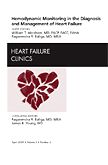Hemodynamic Monitoring in the Diagnosis and Management of Heart Failure, An Issue of Heart Failure Clinics, 1st Edition
Authors :
William T. Abraham & Ragavendra R. Baliga
Heart failure incidence increases with age and because the oldest segment of the population in Western countries is the fastest growing, the prevalence of heart failure is expected to increase. Understanding the signs and symptoms of heart failure is
...view more
Heart failure incidence increases with age and because the oldest segment of the population in Western countries is the fastest growing, the prevalence of heart failure is expected to increase. Understanding the signs and symptoms of heart failure is therefore of increasing necessity for physicians. Hemodynamic monitoring provides data on blood flow and pressure to assist physicians in determining the status of the patient's heart and in managing heart failure. This issue provides a detailed picture of the various options for assessing hemodynamics, including clinical assessment, echocardiography, transthoracic impedance cardiography, pulmonary artery catheters, B-type natriuretic peptide levels, and implantable devices.
Your discount code here : #FB456
Heart failure incidence increases with age and because the oldest segment of the population in Western countries is the fastest growing, the prevalence of heart failure is expected to increase. Understanding the signs and symptoms of heart failure is therefore of increasing necessity for physicians. Hemodynamic monitoring provides data on blood flow and pressure to assist physicians in determining the status of the patient's heart and in managing heart failure. This issue provides a detailed picture of the various options for assessing hemodynamics, including clinical assessment, echocardiography, transthoracic impedance cardiography, pulmonary artery catheters, B-type natriuretic peptide levels, and implantable devices.
Author Information
By William T. Abraham, MD, FACP, FACC, FAHA and Ragavendra R. Baliga, MD, MBA, FACP, FRCP, FACC, Inaugural Director, Cardio-Oncology Center of Excellence Professor of Internal Medicine The Ohio State University Wexner Medical Center
| ISBN Number | 9781437704853 |
|---|---|
| Main Author | By William T. Abraham, MD, FACP, FACC, FAHA and Ragavendra R. Baliga, MD, MBA, FACP, FRCP, FACC |
| Copyright Year | 2009 |
| Edition Number | 1 |
| Format | Book |
| Trim | 178w x 254h (7.00" x 10.00") |
| Imprint | Saunders |
| Page Count | 240 |
| Publication Date | 22 Mar 2009 |
| Stock Status | IN STOCK - This may take up to 5 business days to ship |
Write Your Own Review
Only registered users can write reviews. Please sign in or create an account
product
https://www.us.elsevierhealth.com/hemodynamic-monitoring-in-the-diagnosis-and-management-of-heart-failure-an-issue-of-heart-failure-clinics-9781437704853.html
5950
Hemodynamic Monitoring in the Diagnosis and Management of Heart Failure, An Issue of Heart Failure Clinics
https://www.us.elsevierhealth.com/media/catalog/product/9/7/9781437704853.jpg
69.29
98.99
USD
InStock
/Medicine/Cardiology
/Clinics
/Clinics
46
4388725
5255041
1
3
8
4182692
5145120
Heart failure incidence increases with age and because the oldest segment of the population in Western countries is the fastest growing, the prevalence of heart failure is expected to increase. Understanding the signs and symptoms of heart failure is therefore of increasing necessity for physicians. Hemodynamic monitoring provides data on blood flow and pressure to assist physicians in determining the status of the patient's heart and in managing heart failure. This issue provides a detailed picture of the various options for assessing hemodynamics, including clinical assessment, echocardiography, transthoracic impedance cardiography, pulmonary artery catheters, B-type natriuretic peptide levels, and implantable devices. Heart failure incidence increases with age and because the oldest segment of the population in Western countries is the fastest growing, the prevalence of heart failure is expected to increase. Understanding the signs and symptoms of heart failure is therefore of increasing necessity for physicians. Hemodynamic monitoring provides data on blood flow and pressure to assist physicians in determining the status of the patient's heart and in managing heart failure. This issue provides a detailed picture of the various options for assessing hemodynamics, including clinical assessment, echocardiography, transthoracic impedance cardiography, pulmonary artery catheters, B-type natriuretic peptide levels, and implantable devices.
0
0
add-to-cart
9781437704853
2011 and earlier
Professional
By William T. Abraham, MD, FACP, FACC, FAHA and Ragavendra R. Baliga, MD, MBA, FACP, FRCP, FACC
2009
1
Book
178w x 254h (7.00" x 10.00")
Saunders
240
Mar 22, 2009
IN STOCK - This may take up to 5 business days to ship
By <STRONG>William T. Abraham</STRONG>, MD, FACP, FACC, FAHA and <STRONG>Ragavendra R. Baliga</STRONG>, MD, MBA, FACP, FRCP, FACC, Inaugural Director, Cardio-Oncology Center of Excellence Professor of Internal Medicine The Ohio State University Wexner Medical Center
Clinics
Clinics
The Clinics: Internal Medicine
No
No
No
No
Please Select
Please Select
Please Select
Related Products
-
35% OFF
 Flash Cards
Flash Cards
-
35% OFF
 Book
Book
-
35% OFF
 Flash Cards
Flash Cards
-
35% OFF
 Book
Book
-
35% OFF
 Book
Book
-
35% OFF
 Flash Cards
Flash Cards
-
30% OFF
 Book
Book
-
35% OFF
 Online Resource
Netter's Dissection Video Modules (Retail Access Card)
Online Resource
Netter's Dissection Video Modules (Retail Access Card)University of North Carolina Chapel Hill and Frank H. Netter
Oct 2015
Special Price $117.64 $180.99 -
30% OFF
 Book
Nolte's The Human Brain in Photographs and Diagrams
Book
Nolte's The Human Brain in Photographs and DiagramsTodd W. Vanderah
Jan 2019
Special Price $44.79 $63.99 -
35% OFF
 Book
Book




